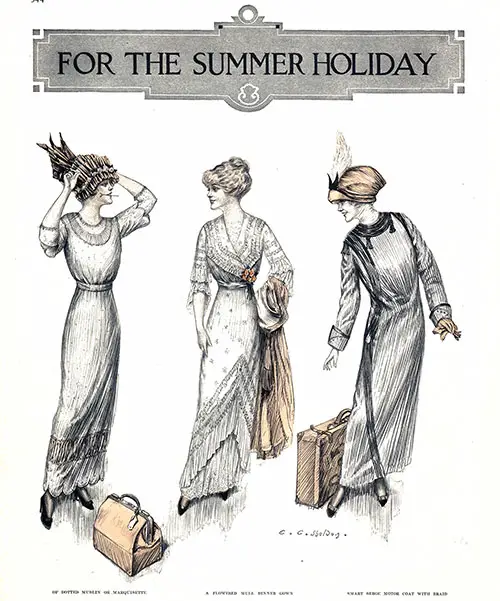Ladies' Summer Holiday Fashions for 1912

(l-r) Outfit of Dotted Muslin or Marquisette; A Flowered Mull Dinner Gown; and a Smart Serge Motor Coat with Braid.
A very becoming gown can be made from the first design on this page. Supposing that muslin or marquisette has been the material is chosen—a colored background with white dots—the bottoms of the skirt and sleeves are bound with a plain green or blue to match.
The pleated bands of plain batiste are edged with a tiny gathered fold of the same plain muslin which likewise forms the girdle and panel sash end. Almost every woman has her decided opinion as to the color which is most becoming to her.
The fair-haired girl will invariably center her interest on pale blue and pink, though often an untried green, though she has never suspected it, will tone in admirably with her coloring.
The desire for pastel shades has been greatly supplanted by colors of a richer note, for they give a better background for fichus or scarfs.
The center design is of flowered mull made over an underskirt with a deep Valenciennes lace ruffle.
The shirrings are of a plain color to match the floral design. Careful consideration must be given to the girdle; if the puffings are to be of blue make the wide soft girdle of wisteria-colored satin and bring the colors together by introducing at the side flowers of blue and violet, as this promises a most exquisite combination.
The upper ends of the sash panel are laid in finely pressed pleats gathered at the top with a ruche of Valenciennes lace. This panel hangs full and wide to the foot of the skirt.
One of the most difficult wraps to fashion is the motor-coat which is practical and yet varied from the ordinary style of pongee or cloth. The right-hand picture offers new suggestions.
This coat is made of dark-blue serge and trimmed with four-inch black braid put on as a binding. The fastening is made on the left shoulder and below the coat is buttoned with but a single button on the hip.
The tasseled ornaments are of black, green, and red, with a cord to match across the cuff. There is practically no difference between the back and front of this coat and the only color actually introduced is the satin lining of American Beauty red.
If made of white serge it will make an excellent coat to wear over lingerie gowns or to take the place of the white polo coat, which has somewhat lost its exclusiveness.
Besides the necessary neckwear, gowns, and blouses, a very useful possession is the separate guimpe which is often needed for gowns that are cut rather low in the neck.
Often one wishes to lend a more formal appearance to a costume. For this reason, we have these serviceable under-blouses made of net or batiste.
"For The Summer Holiday," in Harper's Bazar, New York: Harper & Brothers Publishers, Vol. XLVI, No. 7, July 1912, p. 344.
Editor's Note: Some terminology used in the description of women's clothing during the 1800s and early 1900s has been changed to reflect more modern terms. For example, a women's "Toilette" -- a form of costume or outfit has an entirely different common meaning in the 21st century. Typical terms applied to "toilette" include outfit, ensemble, or costume, depending on context.
Note: We have edited this text to correct grammatical errors and improve word choice to clarify the article for today’s readers. Changes made are typically minor, and we often left passive text “as is.” Those who need to quote the article directly should verify any changes by reviewing the original material.
